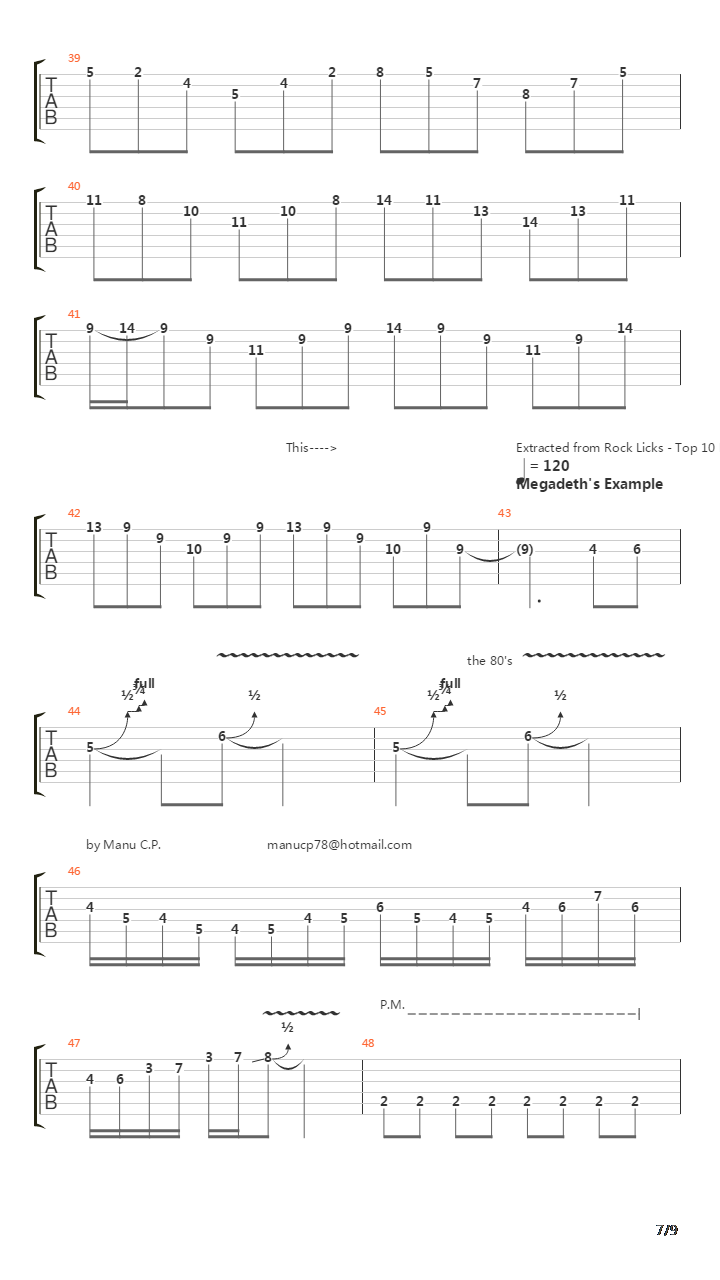标题:Easy Arpeggios Theory
制谱人:George Andrew Brindeiro
指示:skatanic_slug@hotmail.com
附注:
I don't intend to teach anyone any lessons. I just want
to pass on the knowledge I acquired by researching
the net and studying by myself, and if someone doesn't
agree with something I said please tell me.
I'm just a 15 year old dude! hehe
This is my first real lesson I hope you like it.
More tabs in Sudden Rush - my band - (Punk/Grunge,
Pop/Rock) and Weird Things for Weird People
(Compositions). Check them out!
节拍:♩ = 75
音轨:
- Lead and Text - 驱动音效吉他 Overdriven Guitar
- Chords - 驱动音效吉他 Overdriven Guitar
注释:Hey people. I'm here to talk about arpeggios.(An Example)Cool Huh?You CAN do that, and even more elaborate ones.(Hard? I know I can't play that! hehe.. =P)All you need to have is basic scales knowledge.Oh and of course, practice study and a teacherlike me (hehe jk)If you've been studying for a while you will haveprobably heard of them.(C Major Scale)Yes! The old Do-Re-Mi you learned in schoolis worth something!First thing for Major Scales: you need to knowtheir formula to build them properly.It is TONE-TONE-SEMITONE-TONE-TONE-TONE-SEMITONETTSTTTSGot it? NO??ok..What I mean by that is the interval betweenone note and the other.Between C and D there's one TONE, but betweenE and F only a SEMITONEA tone is equivalent to jumping one fret in theguitar and a semitone is just jumping to the next.Now with that formula you can build any majorscale!C MajorD MajorF# Major for 2 Octaves (sharps can be major!)The notes in any scale are divided into "graus", numbers, i dont know the word in english.. heheKnowing this is extremely important forchord contruction and arpeggio theory12345678 (an octave up from 1, that is, same note)You probably noticed I use C Major a lot. Well itsjust cuz its easier for people to visualizeBut ill variate. That was A major.You probably noticed also scales followa graphical pattern in the guitar's fretboard.I wont talk about that, but you should memorizethem and connect them throghout the fretboard.There are explanatory exercises on MSB on that.You can also check in GPro's fretboard the scalessection.There are some weird ones heheMoving on, now a bit of chord construction.A Major Chord is formed by the tonic (1), whichgives the name to the chord and its 3rd and 5th, and a minor chord by 1, 3b (one semitone lowerthan 3)and 5 as well.To give it some spice you can add the 7th or 7b (one semitone lower)- these are maj7(major chord with 7th), 7 (major with 7b), m7M(minor with 7th) and m7(minor with 7b) There are millions of other chord structures I won't mention here such as augmented or diminute, just research!Now lets cut the bullshit (oops.. hehe)Whats that good for?This (Brazilian Metal Band's Angra - Carry On)Notice the start on a minor chord then a majorThis:Yngwie Malmsteen's - Too Young to Die, Too DrunkTo LiveThis---->Extracted from Rock Licks - Top 10 Rock Licks fromthe 80'sby Manu C.P.manucp78@hotmail.comAnd This-->Greg Howe(also taken from rock licks 80's)-Try to find the pattern of chords-Thats all folks. Remember to always study, research, and practice!One More Golden Rule: ALWAYS REMEMBER--> In a major scale, 1, 4 and 5 are major chords; 2,3 and 6 are minor and 7 is diminished.That way its easier to identify which scales touse in a chord progression and which chords in ariff.Many Thanks.contact: skatanic_slug@hotmail.comC5 (Power Chord, no distinction between maj/min)This is called pitch-shifting or harmonizingJason BeckerTA vibThats all folks. Remember to always study, research, and practice!One More Golden Rule: ALWAYS REMEMBER--> In a major scale, 1, 4 and 5 are major chords; 2,3 and 6 are minor and 7 is diminished.That way its easier to identify which scales touse in a chord progression and which chords in ariff.Many Thanks.contact: skatanic_slug@hotmail.com
标记:IntroScalesChord ContructionAngra ExampleMalmsteen's ExampleMegadeth's ExampleGreg Howe's Example








